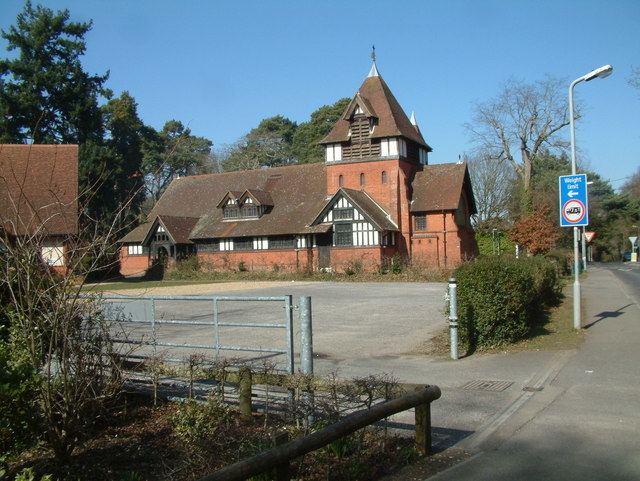Local time Wednesday 5:42 PM | ||
 | ||
Weather 12°C, Wind W at 18 km/h, 94% Humidity | ||
Colehill is a parish, neighbouring Wimborne Minster, in Dorset, England, with a population of 7,000 (2001), reducing slightly to 6,927 at the 2011 census.
Contents
Map of Colehill, UK
History
The name Colehill originated in 1431 as Colhulle, becoming Colhill in 1518 and Collehill in 1547, but the origins of Colehill as a settlement predate this by a long way.
Six round barrows, which can still be seen, show that people lived here as early as 2000 BC. The River Stour would have been navigable and there is evidence that in about 500 BC peoples from Continental Europe were populating the South West, bringing with them the culture of the early Iron Age. Fortifications at Hengistbury Head and more forts inland were established then.
Part of the tracks survive, running parallel to the river from the coastal fort through modern locations such as Parley and Stapehill to Badbury Rings. It is very likely that the line of Middlehill Road derives from one of these very early tracks.
Later in Roman times Wimborne developed as an important trading centre on the River Stour, and as a junction for further tracks from Poole to Badbury Rings and on to Salisbury. Another track radiating eastward possibly set the line for what was to become in modern times the A31. Bridges replaced the fords (Canford) in about 100 AD.
There then followed the Saxon invasion and the formation of the Kingdom of Wessex. Agriculture became established and with it clearance of some small plots on the sunny heathland slopes around Colehill. Over the centuries farms grew until, with the impetus of the Inclosure Acts (1750 to 1860), they were consolidated into the estates that we know of today - Kingston Lacy, Hanham and Uddens.
Colehill today
In Colehill there are three first schools: Colehill First School, Hayeswood First School and St Catherine's. The middle school is St Michael's. There is also a memorial hall, and a community library was opened in February 2013; it is run by volunteers with some support from Dorset County Council. Colehill also has one post office, a pharmacy and a hairdressers.
The latest parish plan for Colehill was published in 2008. Many of the planned actions have been implemented. A website was published in November 2008; it is updated regularly and all local organisations are encouraged to contribute. A half-yearly newsletter, the Colehill Clarion, carries the news from the Parish Council. Colehill appears on Twitter and Facebook. Traffic calming in Middlehill Road has been introduced and the major roundabout on the A31 at Canford Bottom has been re-engineered. The latest parish initiative is a project to rebuild the Reef as a community centre for the young people of Colehill and Wimborne. Funds of over £500K have been raised and building is proceeding.
There are a few houses in Colehill dating from the 1860s and rapid expansion took place in the last century. The population rose from 1786 in 1951 to 5370 in 1971. Several large estates of modern family homes were built and there is quite a lot of infill building. The Parish Church, Church of England, is St Michaels and All Angels. It was designed by Caröe in 1893 and is a half brick and half timber construction in the Arts and Crafts style. Nearby and close to the war memorial at the centre of the village are the Triangle Woods which have village green status. There are areas of common land, a recreation ground at Oliver's Park, and a Local Nature Reserve at Leigh Common. The area is well wooded and the local Forestry Commission plantation at Cannon Hill is available for recreation.
The District Council's Core Strategy, approved in 2013, places over half of East Dorset's New Neighbourhood development in Colehill; it comprises 630 homes along the Cranborne Road and 350 south of the Leigh Road A31. As of 2014 a significant part of Colehill (containing the parish church, war memorial and three of the schools) may be designated as a parish ward of Wimborne in a Community Governance Review.
Notable residents of Colehill include Tim Berners Lee:, the founder of the World Wide Web and actor Michael Medwin. Footballer Roger Johnson spent most of his childhood in the village. Musician Al Stewart also grew up in Colehill
Politics
There are two electoral wards within the parish (east & West).
Colehill became part of the Mid Dorset and North Poole constituency at the 2010 general election.
